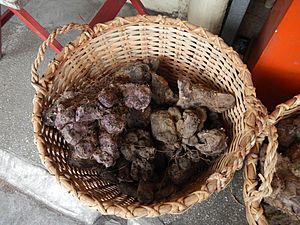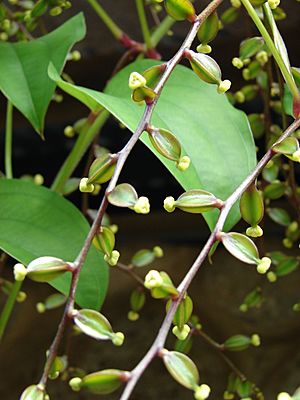Purple yam facts for kids
Quick facts for kids Purple yam |
|
|---|---|
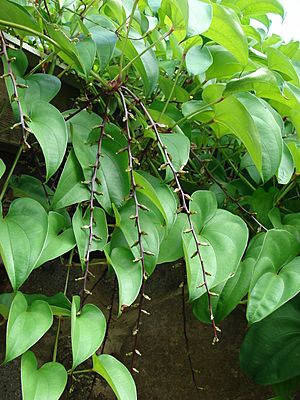 |
|
| Purple yam at Maui, Hawaii | |
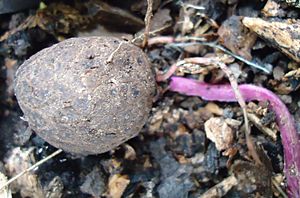 |
|
| Purple yam tuber | |
| Scientific classification | |
| Genus: |
Dioscorea
|
| Species: |
alata
|
Dioscorea alata, also known as purple yam or ube, is a type of yam. Yams are starchy plants with edible underground parts called tubers. These tubers are often a bright violet-purple or lavender color. This is why it's called purple yam! Some purple yams can also be cream or white.
People sometimes confuse purple yam with taro or the Okinawa sweet potato. However, purple yam is its own unique plant. It first grew in the warm, tropical parts of Asia and has been used by humans for a very long time.
Contents
Different Names for Purple Yam
Purple yam has traveled all over the world. It started in Asia and then grew in places like tropical Africa, Australia, South America, and the southeastern U.S. Because of this, it has many different names.
In English, besides "purple yam," people also call it "ten-months yam," "water yam," "white yam," "winged yam," "violet yam," or "Guyana arrowroot." Sometimes, people just call it "yam."

How Purple Yam Was Grown Over Time
Purple yam is a very important food for Austronesian cultures. These are groups of people who live in places like Southeast Asia and the Pacific Islands. They have grown yams for their starchy tubers for thousands of years.
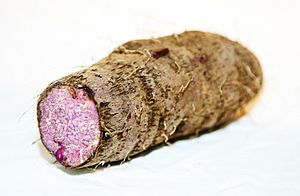
Many different kinds of yams were grown in Island Southeast Asia and New Guinea. Some examples include the round yam, ubi gadong, and lesser yam. Purple yam (D. alata) and lesser yam (Dioscorea esculenta) were the most commonly eaten. Other yams were often eaten only when food was scarce. This is because some yams have natural chemicals that need special preparation to make them safe to eat. Purple yam is grown more than lesser yam because its tubers are much bigger.
Purple yam and lesser yam were easy to carry on Austronesian ships. This helped them spread across the Austronesian expansion areas. Purple yam was brought to the Pacific Islands and New Zealand. It also traveled with Austronesian voyagers to Madagascar and the Comoros.
We don't know exactly where purple yam first came from. However, old findings show it was used in Island Southeast Asia and New Guinea even before the Austronesian people spread out. Purple yam is thought to be a true cultigen. This means it only exists because humans grow it. Most purple yam plants cannot reproduce on their own. This shows that humans had to move them to new islands.
Some people think purple yam came from Mainland Southeast Asia. But it shows the most differences in its looks in the Philippines and New Guinea.
Old farming sites and plant remains in Kuk Swamp in New Guinea suggest that purple yam was first grown there around 10,000 years ago. It then spread to Island Southeast Asia with the Lapita culture about 4,000 years ago.
Even older remains, possibly purple yam, have been found in the Niah Caves of Borneo (over 40,000 years ago) and the Ille Cave of Palawan (about 11,000 years ago). This shows that people knew how to use starchy plants a very long time ago. It also makes us wonder if purple yam is even older than we thought.
Purple yam is still an important crop in Southeast Asia. In the Philippines, the bright purple kind is used in many traditional and new desserts. In Melanesia, it's also grown for special ceremonies. The size of the tubers at harvest time is very important for these events. However, in eastern Polynesia and New Zealand, purple yam became less important after other crops, like the sweet potato, were brought in.
How People Use Purple Yam
Cooking with Purple Yam
Purple yams have edible tubers that taste a little sweet, earthy, and nutty. They can remind you of sweet potatoes or taro. The purple kinds make dishes a beautiful, bright violet color. This is because they have a lot of natural purple pigments called anthocyanins. Purple yams are also valued for their starch.
Purple yam is very popular in Philippine cooking. It is known as ube or ubi there. It's used in many Filipino desserts, like ube cake, ube cheesecake, and ube crinkles. It's also an ingredient or flavor for ice cream, milk, donuts, tarts, jam, and other pastries. People often eat it boiled, baked, or as a sweet dessert called ube halayá. Ube halayá is a popular part of the iced dessert called halo-halo. Purple yam desserts have become popular in the United States too, often called "ube." People love the striking violet-purple color it adds to desserts.
In Vietnam, purple yam is used to make a creamy soup called canh khoai mỡ. In Maharashtra, India, stir-fried purple yam chips are eaten during religious fasting. Purple yam is also a key ingredient in a dish called Undhiyu. It is a popular dessert in Jaffna, Sri Lanka.
Purple yam is often confused with purple sweet potatoes because they look and taste similar. However, purple yam usually has a moister texture than sweet potatoes. Purple yams also have more of those purple pigments (anthocyanins) than sweet potatoes. You can often use them in the same recipes.
-
Ube halaya (mashed purple yam) from the Philippines
-
Binignit from the Philippines
-
White ube halaya from California
-
A slice of ube cake
-
Filipino Ube donut
-
Halo-halo with ube halaya
Other Uses for Purple Yam
The purple color in purple yams comes from pigments called anthocyanins. These pigments dissolve in water and could be used as natural food coloring agents.
Sometimes, people grow D. alata in their gardens just because it looks pretty.
Purple Yam as an Invasive Plant
Dioscorea alata is originally from Southeast Asia and nearby areas. However, it has spread from its native home and now grows wild in many other places. It has become naturalized in parts of China, Africa, Madagascar, the Americas, and various islands in the Indian and Pacific oceans.
It grows wild in Haiti and parts of the United States, including Louisiana, Georgia, Alabama, Puerto Rico, and the U.S. Virgin Islands. In Florida, it is even considered an invasive species. This means it grows so well that it can harm the local plants and environment.
See also
 In Spanish: Ube para niños
In Spanish: Ube para niños


